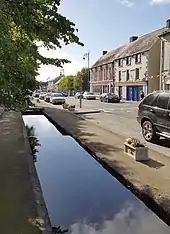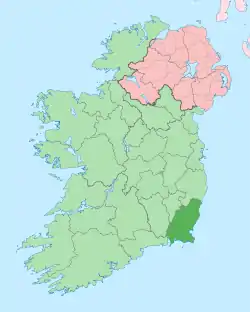Bunclody
Bunclody (Irish: Bun Clóidí, meaning "bottom of the (river) Clody"), formerly Newtownbarry (until 1950), is a small town on the River Slaney in Wexford, Ireland. It is located near the foot of Mount Leinster. Most of the town is in County Wexford; a small area at the north end of town is in County Carlow. Bunclody has received a number of high scores in the Tidy Towns competition. The town is known for the "Streams of Bunclody Festival" held during the month of July.[2] Bunclody was an All-Ireland Pride of Place Winner in 2018. A volunteer led tourist office is open in the town.
Bunclody
Bun Clóidí | |
|---|---|
Town | |
 The Town itself | |
 Bunclody Location in Ireland | |
| Coordinates: 52.655°N 6.651°W | |
| Country | Ireland |
| Province | Leinster |
| County | Wexford |
| Elevation | 52 m (171 ft) |
| Population (2016)[1] | 1,984 |
| Irish Grid Reference | S909569 |

The R746 regional road intersects the N80 in the middle of Bunclody.
| Year | Pop. | ±% |
|---|---|---|
| 1821 | 1,095 | — |
| 1831 | 1,430 | +30.6% |
| 1841 | 1,437 | +0.5% |
| 1851 | 1,307 | −9.0% |
| 1861 | 1,097 | −16.1% |
| 1871 | 1,014 | −7.6% |
| 1881 | 960 | −5.3% |
| 1891 | 909 | −5.3% |
| 1901 | 890 | −2.1% |
| 1911 | 884 | −0.7% |
| 1926 | 709 | −19.8% |
| 1936 | 684 | −3.5% |
| 1946 | 699 | +2.2% |
| 1951 | 805 | +15.2% |
| 1956 | 976 | +21.2% |
| 1961 | 891 | −8.7% |
| 1966 | 940 | +5.5% |
| 1971 | 929 | −1.2% |
| 1981 | 1,467 | +57.9% |
| 1986 | 1,423 | −3.0% |
| 1991 | 1,316 | −7.5% |
| 1996 | 1,241 | −5.7% |
| 2002 | 1,361 | +9.7% |
| 2006 | 1,863 | +36.9% |
| 2011 | 2,012 | +8.0% |
| 2016 | 1,984 | −1.4% |
| [3] | ||
Name
During the 17th century, the name of the town was changed from Bunclody to Newtownbarry, but was reverted to its original name in the 20th century, following Irish independence. The change was made official by a local government order in 1950.[4]
History
Although a hamlet already existed here, Bunclody was raised to the status of a post town in 1577 by alderman James Barry, sheriff of Dublin.[5][6]
The town was the scene of the Battle of Bunclody during the 1798 rebellion.
In the 19th century, a small canal was made, drawing water from the Clody river, to provide drinking water for the town.[7] The canal still flows along the middle of the town's main street. During the Tithe War, 1830–1836, 'Newtownbarry' was the scene of a clash between locals and the officials of the Crown. Locals had become enraged by the seizure of property by the police and army to pay for the Protestant Episcopal polity. According to James Connolly, "twelve peasants were shot and twenty fatally wounded".[8]
In 1884, a metal bridge was built across the River Slaney upstream from today's bridge. It was built of iron from New Ross, and assembled in the bridge meadow beside where the bridge stood. This bridge was washed away in 1965 by a flood. The remains of the bridge were visible from the bank of the river for some years, until it was removed in 2007, during the building of Bunclody Golf and Fishing Club beside the River Slaney.
Among the amenities of the town there are number of GAA and soccer pitches, an outdoor swimming pool (open 2½ months of the year), an aparta-hotel, and two primary and two post-primary schools and an Adult Education & Training Centre.
Demography
Bunclody-Carrickduff is a census town split between County Carlow and County Wexford. It comprises the town of Bunclody and the adjoining village of Carrigduff, and had a population of 1,984 at the 2016 census.[1] An increase from 1,863 as of the 2006 census.[9]
Demographically, a number of nationalities are represented, with approximately 13% of its population being Polish,[10] and approximately 11% Irish Traveller.[11]
Schools
The town has two primary schools: Bunclody National School and Carrigduff National School. There are two secondary schools. The FCJ Secondary School, and Bunclody Vocational College. The FCJ was founded by a French order of nuns in 1861. The school was a boarding school for girls throughout the 20th century. The all girls school provided education for day pupils and accepted male day pupils from the late 1960s when the school became co-ed. The old boarding school was demolished in 2002. The school has several football, hurling and basketball teams, which compete at a national level.
Economy
As a market town, Bunclody featured in the Irish Pavilion in the 2018 Venice Architectural Biennale alongside 9 other Irish market towns. There is an "Urban Adventure Hub" at Ryland Road which allows access to water sports on the River Slaney. This project is managed by WWETB Slielbaggan Outdoor Activity Centre. There are a number of walking trails along the Clodey Valley and off-road trails at Coolmeelagh and Kilbranish. It is also the starting point for the Columban Way from Bunclody, County Wexford to Bangor, County Down and on through mainland Europe to Bobio in Italy following the life journey of St. Columbanus, born circa 540 AD near the Nine Stones.[12] Bunclody Golf and Fishing Club, voted by the Golfer's Guide to Ireland as the 'Best Hidden Gem in Ireland', hosted the Irish PGA in August 2019. [13]
Transport
Road
The town is approximately 20 minutes drive to the M9 motorway and 10 minutes drive to the new M11.
Bus
Bunclody is served by Local Link bus routes 368 (Bunclody to Enniscorthy) and 369 (New Ross to Tullow via Bunclody).[14] Wexford Bus also provides a scheduled service from Wexford to Carlow via Bunclody on route 376.[15] 'Ring a Link' buses also serve Bunclody linking it to Carlow.[16] On Thursdays Bunclody is served by Bus Éireann's cross-country service from Rosslare Europort to Dublin via Carnew.
Until April 2015 the town was served by Bus Éireann Expressway route 5.[17]
Rail
Like many small rural towns Bunclody was never served by rail. The nearest station is Enniscorthy railway station approximately 23 kilometres distant.
In the early years of the railways there were plans for two railway lines to serve Bunclody: from Carlow to Bunclody and on-wards to Enniscorthy as well as a Carlow-Tullow-Bunclody line.[18] However neither of the proposals advanced beyond the planning stage.
Golf course
Bunclody Golf and Fishing Club was officially opened in early 2009. The course is on the Carlow side of the town. The 18 hole course is set on 300 acres (1.2 km2) beside the river Slaney, and is home to Ireland's first on-course elevator, which links the 17th green to the 18th tee.
The great spotted woodpecker, Ireland's newest breeding bird, has been spotted here since 2013.[19]
References
- "Sapmap Area - Settlements - Bunclody-Carrickduff". Census 2016. Central Statistics Office Ireland. April 2016. Retrieved 26 December 2019.
- A History of Bunclody, Wexford, Ireland
- www.cso.ie/census and www.histpop.org Archived 2016-05-07 at the Wayback Machine. Figures post 1951 are for Bunclody-Carrigduff, a conurbation that straddles the Wexford-Carlow borders. For a discussion on the accuracy of pre-famine census returns see JJ Lee "On the accuracy of the pre-famine Irish censuses" in Irish Population, Economy and Society edited by JM Goldstrom and LA Clarkson (1981) p54, and also "New Developments in Irish Population History, 1700-1850" by Joel Mokyr and Cormac Ó Gráda in The Economic History Review, New Series, Vol. 37, No. 4 (November 1984), pp. 473–488.
- S.I. No. 281/1950 — Local Government (Change of Name of Non-Municipal Town) Order, 1950.
- Hayward, Richard. Leinster and the City of Dublin, Barker, 1949, p.108
- Brewer, J. N., The Beauties of Ireland: Being Original Delineations, Topographical, Historical, and Biographical, of Each County, Sherwood, Jones, & Co., 1825, p.378
- Bassett, George Henry, Wexford County Guide and Directory, Hibernian Imprints, 1991, ISBN 1-874238-00-6, p. 343-347 (original publication 1885)
- http://www.marxists.org/archive/connolly/1910/lih/chap12.htm
- CSO Census 2006: Table 5, Population of Towns ordered by County and size, 2002 and 2006
- CENSUS 2016 -NON-IRISH NATIONALITIES LIVING IN IRELAND / POLISH by Central Statistics Office, Dublin
- Theme 2 - 3 : Usually resident population by ethnic or cultural background, 2006 Archived 25 July 2011 at the Wayback Machine by Central Statistics Office, Dublin
- https://www.thecolumbanway.eu/
- http://www.theirishgolfblog.com/2013/06/inside-ropes-bunclody-golf-club.html
- http://locallinkwexford.ie/timetable/
- https://www.wexfordbus.com/web/app/uploads/2017/05/376-march-17.pdf
- "Archived copy". Archived from the original on 17 February 2015. Retrieved 18 May 2015.CS1 maint: archived copy as title (link)
- http://www.wexfordpeople.ie/news/bus-route-cuts-reversed-31085684.html
- http://www.rootsweb.ancestry.com/~irlcar2/Railways_Carlow.htm
- "Great Spotted Woodpecker (Dendrocopos major) - Irish Birding". www.irishbirding.com. Retrieved 5 April 2018.
